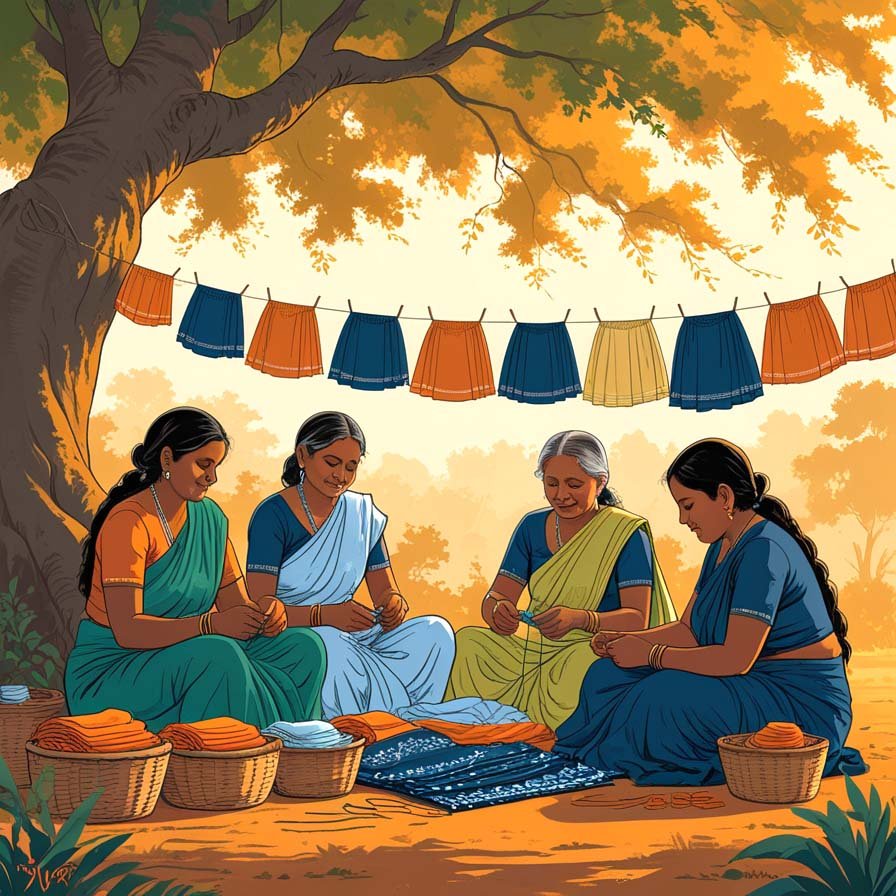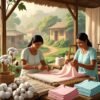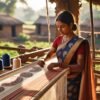
The Art of the Poplin Petticoat (Saya) Best-Kept Secret Simple in Designs.
In the heart of India’s villages, where the rhythm of life syncs with the clatter of handlooms and the hum of shared stories, a humble yet essential garment is born the Poplin fabric petticoat, locally known as Saya. More than just an undergarment, the Saya is a symbol of cultural pride, practicality, and the unbreakable bond among village women who stitch them with skill and solidarity. This article unravels the journey of Poplin fabric, the meticulous craft of creating Sayas, and the inspiring collaboration of rural women who keep this tradition alive.
Poplin Fabric: The Unsung Hero of Comfort and Durability
Poplin, a plain-weave cotton fabric characterized by its fine ribs and smooth texture, has been a staple in textile history. Originally woven with silk warp and wool weft in medieval Europe, modern Poplin is crafted from 100% cotton, making it lightweight, breathable, and remarkably durable. Its tightly woven threads resist wrinkles and fraying, ideal for garments like petticoats that require both strength and softness.
For village women, Poplin is the fabric of choice for Sayas due to its:
Versatility: Holds pleats and shapes well, providing structure under sarees or skirts.
Breathability: Perfect for India’s tropical climate.
Affordability: Accessible for everyday use.
The Saya: A Garment Steeped in Culture and Practicality.
In rural households, the Saya is more than an underlayer it’s a daily necessity. Worn beneath sarees or lehengas, it ensures modesty, comfort, and ease of movement for women working in fields, homes, or markets. Traditionally, Sayas are:
- Simple in Design: Minimalistic cuts with drawstrings or elastic waists.
- Functional: Stitched to withstand years of wear and frequent washing.
- Customizable: Tailored to individual measurements for a perfect fit.
Village Women: Weaving Threads of Community and Empowerment.
The creation of a Poplin Saya is not a solitary task but a collective endeavor. In villages across India, women gather in courtyards or cooperative workshops, transforming raw Poplin fabric into finished petticoats through a shared process:
Embellishments (Optional):
For festive Sayas, women add delicate hand-embroidered borders or lace trims, infusing artistry into utility.
Fabric Preparation:
Women pre-wash and sun-dry Poplin to soften it, then cut it into panels using age-old measuring techniques.
Stitching:
Using manual sewing machines or hand needles, they stitch seams, hem edges, and attach waistbands. The rhythmic sound of their work blends with laughter and shared wisdom.
Quality Checks:
Elder artisans inspect each Saya for durability, ensuring no loose threads or uneven stitches.
Why Collaboration Matters.
Skill Sharing: Younger girls learn stitching from elders, preserving intergenerational knowledge.
Economic Independence: Earnings from Saya sales empower women to support their families.
Social Bonding: The workspace becomes a sanctuary for storytelling, problem-solving, and camaraderie.
Challenges and Triumphs: Keeping the Craft Alive.
Despite their cultural significance, Poplin Sayas face modern challenges:
Limited Market Access: Many artisans rely on local fairs or middlemen for sales.
Competition from Synthetic Fabrics: Cheap, mass-produced alternatives flood markets.
How Women Are Innovating.
- Self-Help Groups (SHGs): Collectives like *Udyogini and SEWA help women access bulk orders, loans, and training.
- Eco-Friendly Practices: Using natural dyes and upcycled Poplin scraps for patchwork designs.
- Digital Outreach: Younger generations promote Sayas on social media, connecting with urban buyers.
Why Choose a Handmade Poplin Saya?
- Ethical Choice: Supports rural livelihoods and slow fashion.
- Superior Quality: Hand-stitched Sayas outlast factory-made ones.
- Cultural Preservation: Each stitch carries the legacy of village craftsmanship.
A Day in the Life of a Saya Artisan.
Meet Kavita Roy, a 32-year-old artisan from Berhampore:
“Every morning, after milking the cows and packing lunches for my children, I join my sisters at the workshop. We stitch 20–30 Sayas a day, chatting about village gossip and monsoon rains. When urban customers praise our work, I feel proud—like my hands have magic.”
How to Support Saya Artisans.
- Buy directly from alpanahighfashion.com.
- Request custom Sayas from rural cooperatives.
- Share their stories to raise awareness about handmade textiles.


